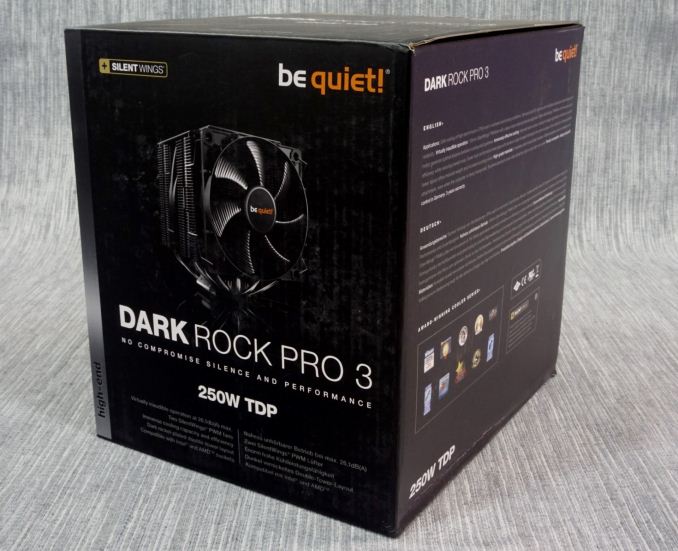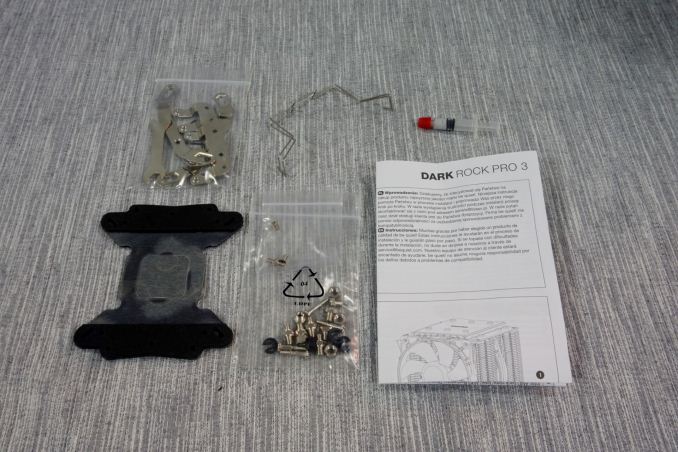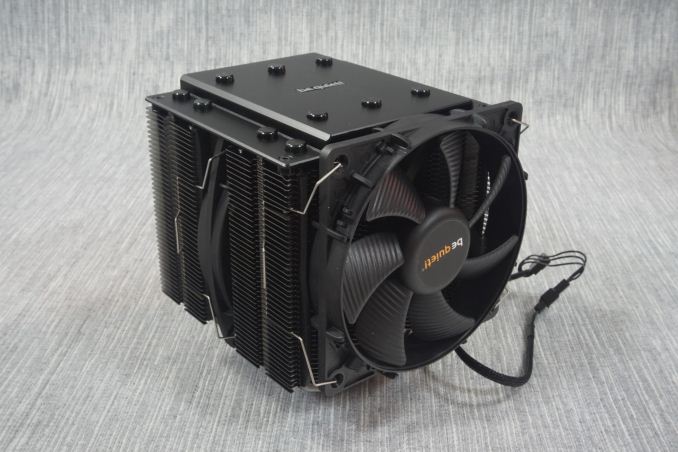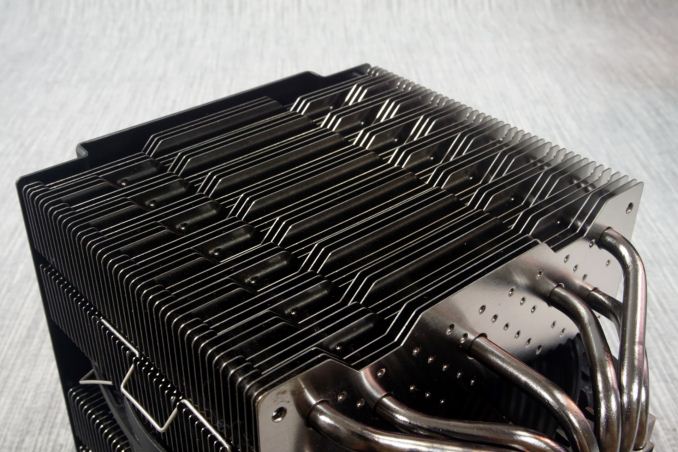Top Tier CPU Air Coolers Q3 2015: 9-Way Roundup Review
by E. Fylladitakis on July 6, 2015 8:00 AM ESTThe Be Quiet! Dark Rock Pro 3
Be Quiet! is a German manufacturer of cooling, case and power PC-related products and one of the few European companies that has managed to push their way into the North American markets. We have checked a few of their power supplies in recent months and most recently saw their new cases and fans at Computex. For this review the company supplied us with the best and largest cooler they currently offer, the Dark Rock Pro 3.
The Dark Rock Pro 3 is supplied into a bizarrely shaped, deep cardboard box, well protected within thick layers of polyethylene foam and cardboard walls. A very basic black and white leaflet with installation instructions and the absolute necessary parts for the mounting of the cooler are supplied, nothing more, with the sole exception of two wire clips for those that want to install a third fan on the cooler.
Much as its name suggests, the Dark Rock Pro 3 is a very large, dark cooler. It is a symmetric dual tower design, meaning that the seven 6 mm heatpipes run through the base and to a separate cooling tower on either side. A metallic black top cover extends across the entire cooling body, covering both towers and the middle cooling fan but leaving the front fan exposed. With the exception of the black top cover, everything else is nickel-plated.
The front of each tower forms a jagged saw tooth design facing the fan that inclines inwards toward the center of the tower, while the rear forms a geometric pattern fashioned from half-octagons. The jagged front is supposed to reduce harsh airflow state transitions and aerodynamic noise, but the rear is most likely shaped for aesthetic purposes only.
The company is using their own SilentWings series fans on the Dark Rock Pro 3. The dimensions of each fan differs, with a 135 mm fan installed between the towers and an 120 mm fan at the front of the cooler. Still, both fans share the same features, such as the decoupling frames, wavy blades and six pole engines with fluid dynamic bearings. They are very high quality and expensive models, yet they are optimized for low noise operation, not high static pressure, which we will see the results of in the testing.
Be Quiet! paid a lot of attention to the base of the Dark Rock Pro 3. It is a very solid construct, forming a small heatsink, possibly to aid the overall performance of the cooler a little bit. The base has been polished to a perfect mirror finish, with no imperfections to be found.















135 Comments
View All Comments
Drumsticks - Monday, July 6, 2015 - link
They did one of these round ups with the 212 Evo or + a while back, also involving high ends from Noctua (U14 and U12S I believe). They found that it doesn't quite match up, but I know it got a mention for exceptional performance for cheap. I think it falls behind more in noise than performance.It definitely would have been interesting to see it in here, but nevertheless, thanks for the review!
kmmatney - Monday, July 6, 2015 - link
I usually undervolt the fan a little - takes care iof any noise issues.Arnulf - Monday, July 6, 2015 - link
+1Nagorak - Monday, July 6, 2015 - link
I would have also liked to have a "decent" CPU cooler like that included, as well as the stock Intel/AMD HSF. It's great seeing how these coolers stack up to one another, but it doesn't truly quantify how much of an improvement you're getting over a cheap alternative, or the stock fan. For the record, I haven't run with a stock fan on any main PC I've owned in the past 15 years, but I would be curious to see how much I'm actually gaining.Araemo - Monday, July 6, 2015 - link
Especially given the raw value of the Hyper 212 Evo at $30, it may get within a degree or two of some of these for half the price or less... which is why my last build had the Hyper 212+ (It's been a few years) - I could have gained maybe 5C by spending 4 times as much.. which didn't seem worth it to me.TheJian - Tuesday, July 7, 2015 - link
AGREED. I have one, and at $29.95 from newegg just a few months ago on sale it was an AWESOME deal. i4790k can do massive oc's with it and even at full load is not terribly annoying with my 5850 causing most noise when gaming. This is still a top seller and for good reason.LittleLeo - Thursday, July 9, 2015 - link
Since its about the most popular cooler for gamers that would have been nice.jay401 - Monday, July 6, 2015 - link
I'm actually really glad to see this article, it's been ages since I've seen a good CPU air cooler roundup and sockets have changed several times over the years so it's nice to know what works well these days.jmke - Monday, July 6, 2015 - link
air cooling has plenty much run into a wall; heatpipes to copper base, aluminum fins on the heatpipes, put 140mm or 120mm fan... there is not a lot of wiggle room, so performance of those that follow this recipe is very close.differentiators now for most part are: socket compatibility, price, installation method. Raw performance/noise is no longer the focus imho if you want a successful product
meacupla - Monday, July 6, 2015 - link
It's not so much socket compatibility, so much as how compatible you can make your heatsink against mobos that have poor design choices.Although not as common on mATX and larger boards, mITX suffers a lot from this, because manufacturers attach fragile bits onto the back of the mobo, near the CPU socket, that interfere with the mounting bracket. Either that, or the CPU socket is placed too close to the PCIe, etc.
That Reeven Okeanos is something I haven't seen since Athlon 64 days, which are heatsinks paired with a stupidly loud fan. Look, if I wanted a heatsink with stupidly loud fan, I would buy an amazing heatsink or watercooler first, then attach the stupidly loud fan to that, instead of some mediocre heatsink with a mediocre fan.